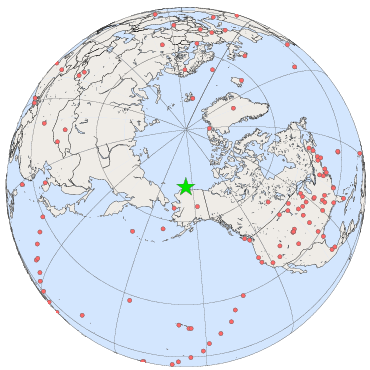 |
Atmospheric Transport |
Description
Barrow Observatory, established in 1973, is located near sea level 8 km east of Barrow, Alaska at 71.32 degrees north. This facility is manned year around by 2 engineers/scientists who often commute to work in winter on snow machines. Due to its unique location, dedicated and highly trained staff, excellent power and communications infrastructure, the Barrow Observatory is host to numerous cooperative research projects from around the world.
BRW is located so that it receives minimal influence from anthropogenic effects. It is about 8 km northeast of the village of Barrow and has a prevailing east-northeast wind off the Beaufort Sea. It is attended at least 5 days a week for routine inspection and maintenance of the instrumentation. In addition, the National Weather Service (NWS) maintains a weather observing facility in Barrow. Although the measurements at Barrow are made over open tundra, there are large lagoons and a number of lakes in the vicinity, and the Arctic Ocean is less than 3 km northwest of the site. Because of its proximity to these bodies of water and the fact that the prevailing winds are off the Beaufort Sea, BRW is perhaps best characterized as having an Arctic maritime climate affected by variations of weather and sea ice conditions in the Central Arctic.
Carbon Cycle Surface Flasks
| Parameter | Formula | First Sample Date | Most Recent Sample Date |
|---|---|---|---|
| Carbon Dioxide | CO2 | 1971-05-03 | 2008-11-22 |
| Methane | CH4 | 1983-04-06 | 2008-11-22 |
| Carbon Monoxide | CO | 1988-07-24 | 2008-11-22 |
| Molecular Hydrogen | H2 | 1988-07-24 | 2008-11-22 |
| Nitrous Oxide | N2O | 1997-05-07 | 2008-11-22 |
| Sulfur Hexafluoride | SF6 | 1997-05-02 | 2008-11-22 |
| Carbon-13/Carbon-12 in Carbon Dioxide | d13C (CO2) | 1990-01-22 | 2008-10-24 |
| Oxygen-18/Oxygen-16 in Carbon Dioxide | d18O (CO2) | 1990-02-05 | 2008-10-31 |
| Carbon-13/Carbon-12 in Methane | d13C (CH4) | 1998-01-03 | 2008-07-03 |
| D/H in Methane | dD (CH4) | 2005-04-01 | 2008-07-17 |
| methyl chloride | CH3Cl | 2005-06-10 | 2008-05-24 |
| Benzene | C6H6 | 2007-02-16 | 2008-05-24 |
| toluene | C7H8 | 2007-02-16 | 2008-05-24 |
| ethane | C2H6 | 2005-06-10 | 2008-05-24 |
| ethene | C2H4 | 2005-06-10 | 2008-04-12 |
| propane | C3H8 | 2005-05-20 | 2008-05-24 |
| propene | C3H6 | 2005-06-10 | 2008-04-12 |
| i-butane | i-C4H10 | 2005-06-10 | 2008-05-24 |
| n-butane | n-C4H10 | 2005-06-10 | 2008-05-24 |
| i-pentane | i-C5H12 | 2005-05-20 | 2008-05-24 |
| n-pentane | n-C5H12 | 2005-06-10 | 2008-05-24 |
| n-hexane | n-C6H14 | 2005-05-20 | 2008-05-24 |
| wind speed | 1992-07-10 | 2008-12-02 | |
| wind direction | 1992-07-10 | 2008-12-02 | |
| ambient temperature | 2004-08-21 | 2004-09-13 | |
| isoprene | C5H8 | 2007-02-16 | 2008-05-24 |
Carbon Cycle In Situ Observatory
| Parameter | Formula | First Sample Date | Most Recent Sample Date |
|---|---|---|---|
| Carbon Dioxide | CO2 | 1973-07-24 | 2008-12-10 |
| Methane | CH4 | 1986-01-29 | 2008-12-10 |
| Carbon Monoxide | CO | 1991-12-31 | 2008-12-10 |
HATS Flask Sampling
HATS In Situ Observatory
Aerosol Surface, Continuous Measurements
Continuous Radiation Measurements
| Parameter | Formula | First Sample Date | Most Recent Sample Date |
|---|---|---|---|
| Direct Beam | 1985-01-01 | Ongoing | |
| Shortwave Global | 1976-02-18 | Ongoing | |
| Diffuse | 1995-07-05 | Ongoing | |
| Reflected Shortwave | 1985-01-01 | Ongoing | |
| Downward Longwave | 1993-04-20 | Ongoing | |
| Upward Longwave | 1993-04-26 | Ongoing |
Ultraviolet Radiation
Surface Ozone
Dobson Ozone
| Parameter | Formula | First Sample Date | Most Recent Sample Date |
|---|---|---|---|
| Total Ozone | Total Ozone | 1973-07-29 | 2005-10-17 |
Trajectories
Meteorology
| Parameter | Formula | First Sample Date | Most Recent Sample Date |
|---|---|---|---|
| wind speed 2 meters | 2008-01-01 | 2008-10-26 | |
| Wind Direction 2 Meters | 2008-01-01 | 2008-10-26 | |
| Wind Speed 10 Meters | 2008-01-01 | 2008-10-26 | |
| Wind Direction 10 Meters | 2008-01-01 | 2008-10-26 | |
| Wind Speed Top | 2008-01-01 | 2008-10-26 | |
| Wind Direction Top | 2008-01-01 | 2008-10-26 | |
| Barometric Pressure | 2008-01-01 | 2008-10-26 | |
| Relative Humidity 2 Meters | 2008-01-01 | 2008-10-26 | |
| Temperature 2 Meters | 2008-01-01 | 2008-10-26 | |
| Temperature 10 Meters | 2008-01-01 | 2008-10-26 | |
| temperature Top | 2008-01-01 | 2008-10-26 | |
| Precipitation | 2008-01-01 | 2008-10-26 |

![[Barrow ]](https://webarchive.library.unt.edu/eot2008/20090109050754im_/http://www.esrl.noaa.gov/gmd/images/brwstation_small.jpg)
![[Trinidad Head ]](https://webarchive.library.unt.edu/eot2008/20090109050754im_/http://www.esrl.noaa.gov/gmd/images/thdstation_small.jpg)
![[Mauna Loa ]](https://webarchive.library.unt.edu/eot2008/20090109050754im_/http://www.esrl.noaa.gov/gmd/images/mlostation_small.jpg)
![[American Samoa]](https://webarchive.library.unt.edu/eot2008/20090109050754im_/http://www.esrl.noaa.gov/gmd/images/smostation_small.jpg)
![[South Pole ]](https://webarchive.library.unt.edu/eot2008/20090109050754im_/http://www.esrl.noaa.gov/gmd/images/spostation_small.jpg)
